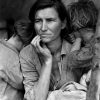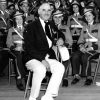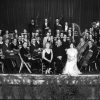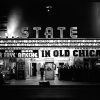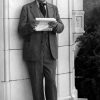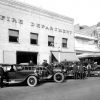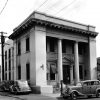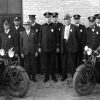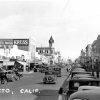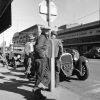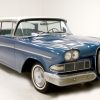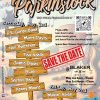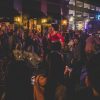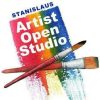The BigView
The great depression, prohibition and the worst of times. These were some of the keys that would later make Modesto great. As we suffered in a tough economy, our irrigation based agriculture would draw people from all over the USA, much like the gold rush in the 1850s. The dust bowl in the south would create an exodus of people that would find a new railroad, that would link the farms with a desperate people that would work the ground, with that train clickity clack that would inspire a hillbilly boogie and lead to a whole new generation of country singers. The popularity of AM radio would take that sound across the USA, even reaching Elvis. Those that continued to grow grapes during prohibition would then find success as two brothers would build the world’s largest winery. Amazing things happened during the 1930s that are still important today. We are going through some tough times right now and you know it will build some strength we will use for the future. Our friend Carl Baggese takes us through the 1930s and we hope you enjoy it and please let us know at info@modestoview.com<mailto:info@modestoview.com> if you have something to add.
Thanks – Chris Murphy
The 1930s
By Carl Baggese
The razzle dazzle of the 1920s, with its flappers, gangsters, speakeasies and light-hearted fun came crashing down in October 1929, when an over-extended economy, with too many stocks bought on margin and no cash to back them up, tumbled to earth-shattering lows. Perhaps the entertainment newspaper, Variety, put it best, headlining in its own peculiar vernacular: “Wall Street Lays an Egg.”
The beginning of the new decade saw jobs disappear, banks close and fortunes disappear. The common person and the wealthy were on an even plain. They were broke – forced to stand in breadlines for a humble meal or to stand on a corner selling apples to bring in cash. No corner of the country was spared in the sweeping Great Depression that followed. Businesses in Modesto suffered as well as those throughout the country.
Yet there is always a bright side, and while the worst part of the decade came with the swirling winds of the Dust Bowl in the Midwest, opportunities opened up with the great migration to California for those who had little hope in their own backyard. In addition, there were always entrepreneurs who could build something from nothing. And so the era also offered some hope as the ship righted itself. When Franklin Delano Roosevelt stood in front of the Capitol Building in Washington, D.C. on March 4, 1933 he offered a New Deal to the American people, telling them they had “nothing to fear but fear, itself.” One of his first acts was to repeal Prohibition – and that had enormous implications for Modesto’s future.
The Legend of Ernest & Julio Gallo
Legend has it that Ernest and Julio Gallo began their winery by borrowing money from Ernest’s mother-in-law, Teresa Franzia, and finding pamphlets about making wine in the McHenry Library. The legend is true.
It was shortly after Prohibition had been repealed in 1933 when the Gallo Brothers began their winery. As Ernest explains in the book, “Ernest and Julio Gallo: Our Story,” they had made homemade wine that tasted like grape juice in December and vinegar in June.
“Obviously, we did not know anything about commercial winemaking. Though money was tight, we searched for a qualified winemaker to hire. But the wait for Repeal to come about had been too long for many experienced winemakers from the pre-Prohibition times . . . unable to hire experienced winemaking help, Julio and I would be completely on our own.
“I went to the Modesto library to look for a book on winemaking. I told the librarian what I had in mind, but she found nothing on the shelves. After all, we were just ending more than a decade of national Prohibition, during which there had been no call for winemaking. As I turned to leave, she remembered some old pamphlets in the basement. ‘There might be some about winemaking from before Prohibition,’ she said. ‘Why don’t you go down and see?’
“I went downstairs and found a stack of magazines and pamphlets. I went through it, and found a pamphlet on fermentation and one on the care of wine by Professor Frederic T. Bioletti of the Department of Viticulture and Enology at the University of California at Davis, published prior to Prohibition. Bioletti had been in the forefront of research being done in enology around the turn of the century. The pamphlets were among a series published by the university, making results of various enological experiments available to early winemakers. These were exactly what we needed. ‘You’re welcome to them,’ the librarian said.
“This was the beginning of our knowledge about making commercial wine, such as how to have a sound, clean fermentation, and how to clarify the wine. These old pamphlets probably saved us from going out of business our very first year . . .”
The brothers are both gone now, but Gallo Wines are known the world over. The winery is still headquartered in Modesto on Yosemite Boulevard and owns brands and wineries that range from the Central Valley to the North Coast, Sonoma and the Napa Valley as well asl importing wines from Italy, Australia and other regions throughout the world. They also make E&J Brandy along with other types of spirits.
Musician Extraordinaire – Modesto’s Music Man
As Modesto started to pay more attention to it cultural needs, the perfect person was ready to help the city establish a reputation in the area of music. Regardless of the tough times, music would play a starring role in the development of the community.
While it’s mostly the people of Modesto who know his name, Frank “Proof” Mancini was playing with the John Philip Sousa band in San Francisco at the Panama Pacific Exposition in 1915 and eventually came to Modesto to play in the orchestra for the opening of the Strand Theatre in 1920. He decided that the Central Valley was very much like his native Italy, and he stayed.
He was the award-winning band director at Modesto High School and helped found the Modesto Symphony Orchestra and the Stanislaus County Boys Band. When the symphony held its first concert in 1931 at the Strand Theatre, the population of Modesto was 17,000. It was the smallest town in the United States to have a symphony orchestra.
He brought culture and music to Modesto and left a legacy that continues today. When he died in 1964, Prof. Mancini was a beloved figure in his adopted hometown. He and his wife left their ranch on River Road to the city to become a park. Mancini Bowl in Graceada Park is home to the Modesto Band of Stanislaus County (MoBand), whose forerunner was the Boys Band.
In 1994, Mancini was posthumously elected into the National Band Association’s Hall of Fame located at Troy State University in Troy, Alabama.
The State Theatre
The talkies came into being in 1927 with Al Jolson in The Jazz Singer, and during the 1930s film became an integral part of survival during the Depression. For a dime you could allow the flickering images on the screen to envelop you with music, comedy or drama. Walt Disney’s Mickey Mouse and child actress, Shirley Temple, led the way with their optimistic outlook on life. At the same time, Broadway composers turned almost anything into a filmed musical adding a plethora of great songs to the American songbook. They filled the drab lives of those trying to survive with a joyful hour or two sitting in the dark surrounded by the opulence of a grand movie palace.
By 1934, movie theatres had gone from palaces to a simpler form and function. Modesto’s State Theatre, designed by architect, S. Charles Lee, whose resumé included some of California’s most elaborate movie houses, opened in December. Lee’s Art Deco movie theatre, with its exquisite plaster murals on the interior walls incorporating leaping gazelles and greyhounds, joined the Modesto, Strand, Princess (later Covell) and Lyric theatres to provide motion pictures to the city’s entertainment hungry population. The Modesto Theatre couldn’t survive the addition of the State and, after removal of its top floor, was turned into retail space on 10th Street, where it still stands. Lee actually designed several movie theatres for downtown Modesto, but the State was the only one actually built.
The State remains the only downtown movie theatre to survive the years. In 2005, it was restored to its former glory, after a modernization in 1960 had stripped away most of its classic Art Deco styling. Though originally built only for film, it has since become a performing arts venue with stage and dressing rooms, adding a badly needed asset to the city’s cultural scene.
Modesto’s New Post Office
By the time the 1930s arrived, Modesto had grown to the point that the leased building being used as the post office was too small. That original building had been financed locally for $26,000 and was leased back to the Treasury Department for ten years. Located on 12th Street, it was replaced in 1933 by a building constructed by the government for $195,000. The new building was located on the same site at 12th and I Sts. Designed in the government’s Renaissance Revival style, the post office opened in October and was used until 1962, when the main post office relocated to Kearney Street. The main highlight in the interior of the post office was artwork created as part of the Treasury Department’s Section of Painting and Sculpture. One percent of the post office’s cost was set aside to fund the art project. The post office originally contained a series of thirteen tempera lunettes depicting agricultural scenes in the Central Valley. The murals were painted by lead artist Ray Boynton and several assistant painters in 1936. The themes of the paintings were Irrigation, Agricultural Products of the Valley, Harvesting of Grapes, Packing Cheese, Grain Harvesting, Meatpacking, Sorting Grapes and Tractor and Plow. While the post office building has been converted into offices, the lobby artwork is still on display, though some panels have been lost over time. The building is on the National Register of Historic Places.
1930s Timeline
1930 Modesto population is 13,842.
1931 First performance of the Modesto Symphony Orchestra. Frank Mancini, Malin Longstroth, and Leonardo Fristrom founded the orchestra during 1929 – 1930.
1933 Franklin Delano Roosevelt is inaugurated on March 4.
The 21st Amendment repealing Prohbition is ratified on Dec. 5.
Ernest and Julio Gallo open a small winery in Modesto with $5,900 borrowed from Ernest’s in-laws, the Franzias. Ernest finds pamphlets on winemaking in the basement of the McHenry Library.
The Modesto Daily Evening News changes its name to The Modesto Bee and News-Herald.
Harvey “Harve” Presnell, stage, film and television actor, is born in Modesto. He will become a Broadway star in Meredith Willson’s “The Unsinkable Molly Brown,” and later star in the movie version with Debbie Reynolds.
Bill Bates Jr. built the first Modesto radio station KTRB 860 AM at the corner of McHenry and Sylvan Ave.
The new Modesto Post Office opens in October at 12th and I Streets. The new building’s lobby features 13 hand-painted murals by Works Progress Administration (WPA) artist Roy Boynton.
1934 The art deco-inspired State Theatre, designed by famed architect S. Charles Lee, opens on December 25. First film is Flirtation Walk.
1936 Carl Shannon home is completed on 17th and I Streets next to Shannon Funeral Home. Shannon serves as mayor of Modesto from 1939 – 1950.
1937 The new Safeway grocery store opens on H Street.
The Maddox Brothers and Rose begin their radio show sponsored by Rice’s Furniture on KTRB am with brothers Fred and Clay and then 11 year old sister Rose, and Rockabilly music is born
1939 War in Europe begins with the German invasion of Poland. The United States remains neutral, but secretly ships armaments to Britain. The Central Valley will play a key role in providing agricultural goods and the Riverbank Aluminum Plant at Claribel and Claus will start making shells for the military.



